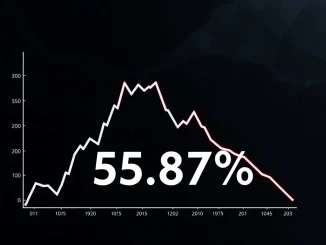
Hold on to your hats, folks! The stock market took a wild ride today, and not the fun kind. If you’re watching your crypto portfolio alongside traditional markets, you might have felt a tremor. The Nasdaq, a key indicator of tech and growth stocks, experienced a significant intraday drop, sending ripples across the financial world. Let’s dive into what happened and what it might mean for you.
What Triggered This Sudden Market Decline?
The markets are complex beasts, and pinpointing one single cause is rarely possible. However, several factors likely contributed to this broad market decline:
- Economic Data Concerns: Recent economic data releases might have spooked investors. This could include inflation figures, jobs reports, or GDP growth numbers that are weaker than anticipated or suggest potential economic slowdown.
- Interest Rate Hikes Anticipation: The fear of further interest rate hikes by central banks to combat inflation often leads to market downturns. Higher interest rates can make borrowing more expensive, impacting corporate earnings and slowing economic growth.
- Geopolitical Uncertainty: Global events and geopolitical tensions always add a layer of uncertainty to the markets. Any escalation in existing conflicts or new geopolitical risks can trigger investor unease and selling pressure.
- Profit Taking: After periods of market gains, investors often engage in profit-taking, selling off some of their holdings to secure returns. This can sometimes lead to broader market corrections.
How Deep Was the Stock Market Drop?
Today’s trading session was undeniably rough for major indices. Let’s break down the numbers:
| Index | Intraday Drop |
| Nasdaq Composite | 4.32% |
| S&P 500 | 3.56% |
| Dow Jones Industrial Average | 2.89% |
As you can see, the Nasdaq took the biggest hit, reflecting potentially heightened concerns in the technology sector. The S&P 500, a broader measure of the stock market, also experienced a significant decline, while the Dow Jones, often seen as more representative of established, blue-chip companies, saw a slightly less severe but still substantial drop.
Is This a Market Crash or Just a Correction?
Financial jargon can be confusing, so let’s clarify. A “market correction” is typically defined as a 10% to 20% decline from a recent high. A “market crash” is a more severe and rapid downturn, often exceeding 20%. While a 4%+ intraday drop is significant, it’s crucial to consider if this is a one-day event or the start of a sustained downtrend.
It’s too early to definitively call this a stock market crash. However, such sharp declines do signal increased volatility and investor anxiety. Whether this is a short-term correction or the beginning of a deeper downturn will depend on various factors unfolding in the coming days and weeks, including further economic data, corporate earnings reports, and global events.
What Does a Falling Nasdaq Mean for Crypto Investors?
You might be wondering, “Why should I care about the Nasdaq if I’m invested in crypto?” While the cryptocurrency market operates 24/7 and has its own dynamics, it’s increasingly intertwined with traditional financial markets. Here’s why Nasdaq’s performance can be relevant to crypto:
- Risk Sentiment: Both tech stocks (heavily represented in the Nasdaq) and cryptocurrencies are often considered risk-on assets. When risk sentiment declines in the broader market, both can experience selling pressure. Investors tend to reduce exposure to perceived riskier assets during times of economic uncertainty.
- Institutional Investment: Growing institutional investment bridges the gap between traditional finance and crypto. Institutions often allocate capital across various asset classes. A downturn in the stock market can lead to portfolio rebalancing, potentially impacting crypto holdings as well.
- Economic Outlook: The factors driving the Nasdaq’s decline, such as inflation and interest rate concerns, affect the overall economic outlook. This, in turn, can influence investor appetite for all asset classes, including cryptocurrencies.
Navigating Market Volatility: Key Takeaways
Market volatility can be unsettling, but it’s also a normal part of the investment cycle. Here are some actionable insights to consider:
- Stay Calm, Don’t Panic Sell: Emotional decisions during market downturns can be detrimental. Avoid impulsive selling based on fear. Review your investment strategy and long-term goals.
- Diversification Matters: A diversified portfolio across different asset classes can help mitigate risk. Don’t put all your eggs in one basket.
- Dollar-Cost Averaging: Consider dollar-cost averaging if you plan to invest further. This involves investing a fixed amount regularly, regardless of market fluctuations, which can average out your entry price over time.
- Do Your Research: Stay informed about market developments, but rely on credible sources. Understand the underlying reasons for market movements rather than just reacting to headlines.
- Long-Term Perspective: Remember that market downturns are often temporary. Focus on the long-term potential of your investments rather than short-term fluctuations.
Conclusion: Riding the Waves of Market Fluctuations
Today’s Nasdaq plunge and broader market decline serve as a reminder of the inherent volatility in financial markets. While such drops can be concerning, they also present opportunities for informed investors. By understanding the factors at play, staying calm, and maintaining a long-term perspective, you can navigate these market fluctuations and position yourself for future growth. Remember, market volatility is a wave; learn to ride it rather than be drowned by it.



